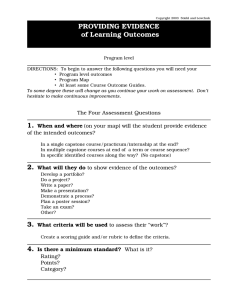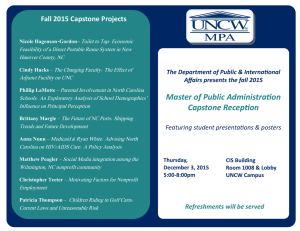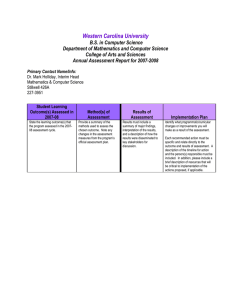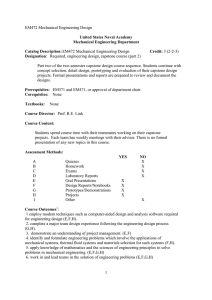Western Carolina University Program Assessment Plan Computer Science Arts and Sciences
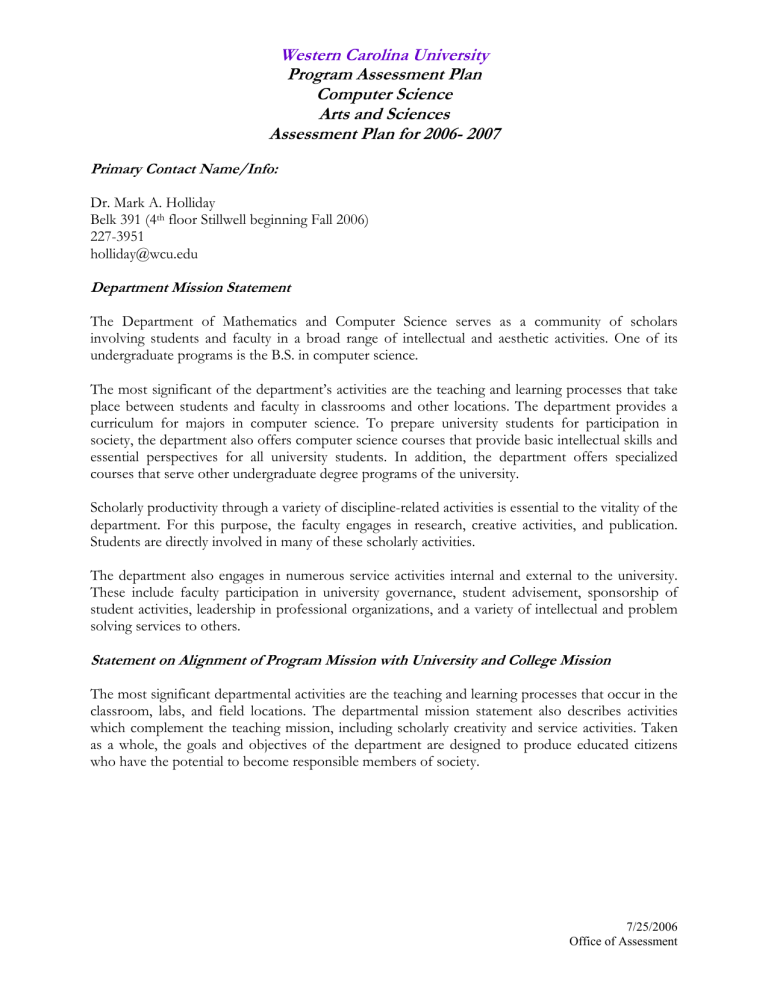
Western Carolina University
Program Assessment Plan
Computer Science
Arts and Sciences
Assessment Plan for 2006- 2007
Primary Contact Name/Info:
Dr. Mark A. Holliday
Belk 391 (4 th floor Stillwell beginning Fall 2006)
227-3951 holliday@wcu.edu
Department Mission Statement
The Department of Mathematics and Computer Science serves as a community of scholars involving students and faculty in a broad range of intellectual and aesthetic activities. One of its undergraduate programs is the B.S. in computer science.
The most significant of the department’s activities are the teaching and learning processes that take place between students and faculty in classrooms and other locations. The department provides a curriculum for majors in computer science. To prepare university students for participation in society, the department also offers computer science courses that provide basic intellectual skills and essential perspectives for all university students. In addition, the department offers specialized courses that serve other undergraduate degree programs of the university.
Scholarly productivity through a variety of discipline-related activities is essential to the vitality of the department. For this purpose, the faculty engages in research, creative activities, and publication.
Students are directly involved in many of these scholarly activities.
The department also engages in numerous service activities internal and external to the university.
These include faculty participation in university governance, student advisement, sponsorship of student activities, leadership in professional organizations, and a variety of intellectual and problem solving services to others.
Statement on Alignment of Program Mission with University and College Mission
The most significant departmental activities are the teaching and learning processes that occur in the classroom, labs, and field locations. The departmental mission statement also describes activities which complement the teaching mission, including scholarly creativity and service activities. Taken as a whole, the goals and objectives of the department are designed to produce educated citizens who have the potential to become responsible members of society.
7/25/2006
Office of Assessment
Program Goals/Objectives
Western Carolina University
Program Assessment Plan
Computer Science
Arts and Sciences
Assessment Plan for 2006- 2007
Outcome Delivery Matrix*
Computer Science
Intended Outcome Course/Experience/Activity Assessment Method
1. Students completing the
B.S. degree in Computer will be able to create and analyze a
1. Students study and create algorithms in all or almost all the Computer Science courses
1. Direct Method. Course
Portfolio in CS 351 (Data
Structures and Algorithms). non-trivial algorithm. in the program, but especially in CS 151 (Problem Solving and Programming II) and CS
351 (Data Structures and
Algorithms). Those two courses are also the primary courses in which students learn to analyze algorithms also.
2. Direct Method. Capstone
Portfolio in CS 495 (Capstone).
3. Direct Method. Capstone
Project.
4. Indirect Method. Graduating
2. Students completing the
B.S. degree in Computer
Science will be able to use all of the steps of the software development process to create high quality software.
3. Students completing the
B.S. degree in Computer
Science will, when given an observed behavior of a single computer or of a distributed system, be able to identify and
1. Students practice developing software in all or almost all the
Computer Science courses in the program; however, the courses that focus especially on developing proficiency in all the steps of the software development process are CS
463 (Introduction to Software
Engineering) and CS 495
(Capstone).
1. The primary required courses emphasizing this subject in the Computer
Science Core (that is, required of all computer science majors) are CS 350 (Introduction to
Senior Exit Group Interview
1. Direct Method. Course
Portfolio in CS 463
(Introduction to Software
Engineering).
2. Direct Method. Capstone
Portfolio in CS 495 (Capstone).
3. Direct Method. Capstone
Project.
4. Indirect Method. Graduating
Senior Exit Group Interview
1. Direct Method. Course
Portfolio in CS 350 explain the key internal events that cause that behavior.
Computer Organization), CS
370 (Operating Systems), and
CS 465 (Computer Networks).
(Introduction to Computer
Organization).
2. Direct Method. Capstone
Portfolio in CS 495 (Capstone).
3. Direct Method. Capstone
Project.
7/25/2006
Office of Assessment
4. Students completing the
B.S. degree in Computer
Science will be able to articulate a well thought-out judgment on legal, social, and ethical issues associated with computing.
5. Students completing the
B.S. degree in Computer
Science will be able to express ideas effectively in oral and written form.
Western Carolina University
Program Assessment Plan
Computer Science
Arts and Sciences
Assessment Plan for 2006- 2007
1. The primary course that
4. Indirect Method. Graduating
Senior Exit Group Interview
1. Direct Method. Capstone addresses this topic is CS 495.
(Capstone).
Portfolio in CS 495 (Capstone).
2. Direct Method. Capstone
Project.
3. Indirect Method. Graduating
Senior Exit Group Interview
1. We emphasize written communication skills in all of the Computer Science courses primarily through software documentation and other technical writing that is part of the software development process (requirements specifications, design documents). In certain courses reports and essays are required.
CS 463 (Introduction to
Software Engineering) and CS
495 (Capstone) are courses that have especially significant amounts of writing.
1. Direct Method. Capstone
Portfolio in CS 495 (Capstone).
2. Direct Method. Capstone
Project and accompanying report.
3. Indirect Method. Graduating
Senior Exit Group Interview
6. Students completing the
B.S. degree in Computer
Science will be able to work well with others.
1. We create experiences for students to achieve this student learning objective primarily through developing software in teams. Teams are encouraged, but not mandated in most of our courses. We specifically require software development in teams and address issues in team dynamics in CS 463
(Introduction to Software
Engineering).
1. Direct Method. Course
Portfolio in CS 463
(Introduction to Software
Engineering).
2. Direct Method. Capstone
Portfolio in CS 495 (Capstone).
3. Direct Method. Capstone
Project.
4. Indirect Method. Graduating
Senior Exit Group Interview
7/25/2006
Office of Assessment
7. Students completing a computer science course designed for non-majors will by the end of the course be able to create a non-trivial program.
Western Carolina University
Program Assessment Plan
Computer Science
Arts and Sciences
Assessment Plan for 2006- 2007
1. Our non-major courses are
CS 130 (Introduction to
Computing) and CS 140
1. Direct Method. By the end of the course the student must have independently designed
(Problem Solving and
Programming for Engineers). and created a non-trivial program.
This student learning objective is for the students in those courses.
*Adapted from Bresciani, M.J., 2003, Identifying Projects that Deliver Outcomes and Provide a Means of Assessment: A Concept
Mapping Checklist, NASPA Net RESULTS.
Statement on Alignment of Program Goals/Objectives with University and College Mission
The program student learning objectives given above for the B.S. in Computer Science are closely tied to the University's mission statement. The alignment of our undergraduate program student learning objectives with the aspirations of Western Carolina University (page 5 of the 2005-2006
Undergraduate Catalog) is emphasized below: a. Student learning objectives 1, 4, 5, 6, and 7 provide discipline-specific objectives concerning communication, problem solving, and critical thinking. These goals are aligned with the first aspiration of the university. b. Student learning objectives 1, 2, and 3 encompass the intellectual and technical skills of the discipline, in alignment with the second aspiration of the university. c. As an extension of Goal 1, it is hoped that our students not only exhibit the ability to reason
logically, but that they gain an appreciation of the problem-solving process, and that this appreciation leads to a life-long interest in learning, in alignment with the fourth aspiration of the University. d. As an extension of Goal 4, it is hoped that our students’ ability to make well-though-out judgments about legal, social, and ethical issues will provide a basis for continued personal development and a life-long interest in learning, in alignment with the fourth aspiration of the University.
7/25/2006
Office of Assessment
